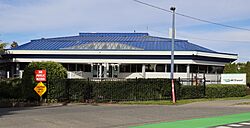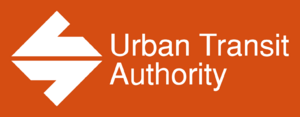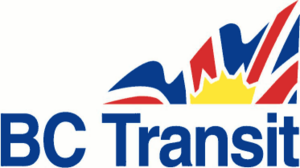BC Transit facts for kids
 |
|
| Founded | 1983 |
| Headquarters | 520 Gorge Road East Victoria, British Columbia |
| Locale | Province of British Columbia (except Greater Vancouver) |
| Service area | 130 communities |
| Service type | bus service, paratransit, transportation planning |
| Fleet | 1,128 vehicles |
| Web site | www.bctransit.com |
BC Transit is a company that runs public bus services across the province of British Columbia, Canada. It is a Crown corporation, which means it is owned by the government. BC Transit's main office is in Victoria, British Columbia.
The company provides bus services to over 130 communities. The only major area it doesn't cover is Greater Vancouver, which has its own transit system called TransLink.
BC Transit's story began with the British Columbia Electric Railway, which started in 1897. This company later became part of BC Hydro. In 1979, the government created a new agency just for transit called the Urban Transit Authority. This agency was renamed BC Transit in 1983.
Contents
History of BC Transit
The history of public transit in British Columbia goes back to the late 1800s. It started with electric streetcars and trains.
From Streetcars to Buses
In 1897, the BC Electric Railway was formed. It ran electric light rail systems, also known as tramways, in cities like Vancouver, Victoria, and New Westminster.
During the 1930s and 1940s, the company began to replace the old streetcars with trolleybuses and gas-powered buses. In 1961, the government of British Columbia took over the company and made it part of BC Hydro, a government-owned power company.
Creating a New Transit System
In 1979, the government decided to create a separate system just for public transit. This led to the creation of the Urban Transit Authority (UTA). Another company, the Metro Transit Operating Company (MTOC), was formed to run the buses. This new setup gave local towns more say in how their bus systems were run.
In 1983, the UTA and MTOC were combined to create BC Transit. This is the company that exists today.
Modern Changes
In 1999, the transit system in the Greater Vancouver area was handed over to a new company, TransLink. BC Transit continued to manage bus services for the rest of the province.
In 2000, BC Transit was one of the first in North America to start using double-decker buses. These buses have two floors and can carry more people.
When Greyhound Canada stopped its bus services in western Canada in 2018, BC Transit started a new service called BC Bus North. This service connects towns in Northern British Columbia.
To improve safety for bus drivers, BC Transit began installing protective doors on all its buses in 2019.
BC Transit's Services
BC Transit offers several different types of bus services to meet the needs of people across the province.
Local Bus Systems
BC Transit works with local governments to provide bus services in many communities. The only system that BC Transit runs directly is the Victoria Regional Transit System. In other places, the service is run by the local city or by a private company.
Some of the communities with BC Transit services include:
- 100 Mile House
- Agassiz-Harrison
- Ashcroft-Cache Creek-Clinton
- Bella Coola
- Boundary
- Burns Lake
- Campbell River
- Central Fraser Valley
- Chilliwack
- Clearwater
- Columbia Valley
- Comox Valley
- Cowichan Valley
- Cranbrook
- Creston Valley
- Dawson Creek
- Elk Valley
- Fort St John
- Hazeltons
- Kamloops
- Kelowna
- Kimberley
- Kitimat
- Merritt
- Mount Waddington
- Nanaimo
- Pemberton Valley
- Port Alberni
- Port Edward
- Powell River
- Prince George
- Prince Rupert
- Princeton
- Quesnel
- Revelstoke
- Salt Spring Island
- Shuswap
- Skeena
- Smithers
- South Okanagan-Similkameen (Penticton)
- Squamish
- Summerland
- Sunshine Coast
- Terrace
- Vernon
- Victoria
- West Coast Transit (Tofino-Ucluelet)
- West Kootenay
- Whistler
- Williams Lake
HandyDART
HandyDART is a special bus service for people with disabilities or elderly passengers who cannot use the regular bus system. It uses smaller buses or vans to provide door-to-door service. This helps people get to appointments and run errands. HandyDART is available in most large towns and many smaller communities.
BC Bus North
BC Bus North is a bus service that connects towns and cities over long distances in Northern British Columbia. It was created to fill the gap after Greyhound Canada stopped its services. While the buses don't have BC Transit logos, the service is funded and organized by BC Transit. Its main hub is in Prince George.
Health Connections
Health Connections is a bus service that helps people in rural areas travel to bigger cities for medical appointments. While it is mainly for patients, anyone can use the service. These buses run on a set schedule but are not usually listed in the regular local bus guides.





